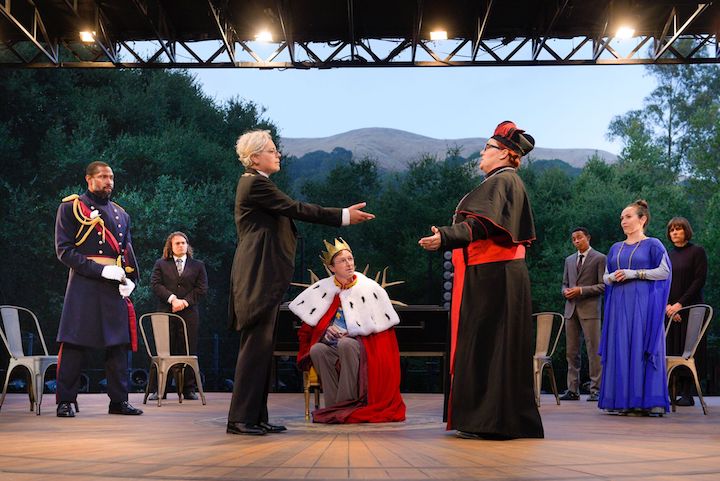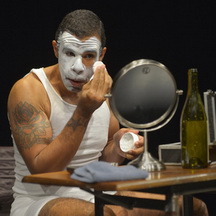The War of the Roses now showing in a four-hour production at Cal Shakes in Orinda is a distillation of four of Shakespeare’s English histories, Henry VI, parts 1, 2 and 3 and Richard III. Consolidating the plays has been done several times in their 400-year-plus theatrical history. This version, a collaboration between Cal Shakes Artist Director Eric Ting and the company’s dramaturg Philippa Kelly, is a company first. Eric Ting directed the production.
The War of the Roses is an epic gesture. An attempt to synthesize the complex dynastic struggle between the royal houses of Lancaster and York that was fought in medieval England during 1455–85. The poetic title of the war, and Cal Shakes’ play, is taken from the heraldic design of the five-petalled rose, with the house of Lancaster favoring the red and York favoring white.

When the last king associated with the Lancastrian family, the half nephew of Henry VI, Henry Tudor, married Elizabeth of York he combined the two roses into the Tudor rose, which had the five white petals of York surrounded by the five red petals of Lancaster, signaling the consolidation of the two houses under the crown. And symbolically marking the end of a no-holds-barred struggle between a group of related and not-so-related power-obsessed maniacs. Or so history tells us.
Recent comments spurred by the finding of Richard III’s skeleton in a parking lot in Leicester in 2012 have suggested that Richard was likely not the salivating viperous hunchback that Shakespeare would have had us believe he was. However, even the most cursory reading of any historical account, besides Philippa Gregory, reveals the medieval English aristocracy as a bloodthirsty lot.
The bloodthirsty bit comes across in this production, though there isn’t a lot of blood per se, even the decapitated heads don’t bleed. But anyway you attempt it, it’s difficult to condense four rather longish Shakespearean plays into four hours. Cal Shakes achieves this by condensing the Henry VI plays radically and Richard III much less so, and focusing on the interaction between the two Houses and more or less eradicating outsiders, such as the French and Joan La Pucelle in Henry VI Part 1. True, Joan of Arc is there in several short snippets, broadcast electronically as a hollow voice from a land and world far distant. But the repercussions of the Hundred Year War between England and France, which activated the War of the Roses, are only faint echoes behind what appears to be a battle of vicious and unrelentingly cunning ambition within the English royalty.
The problem is that it’s hard to keep track of the many cousins and their shifting alliances and duplicities. The theater program provides not only a synopsis but also a family tree indicating lines of succession, marriage and relationship, which frankly only added to my confusion. And the ensuing confusion undermined the compelling language. What were far more successful were the on-stage enactments, pulling it all into focus, finally, on the character of Richard III who is the quintessential schemer, and in turn becomes the symbolic soul of power – a composite of lust, greed and ambition.
The cast of 14 covered 30 roles; six of the cast were women often playing male roles, an ironic twist on theater in Shakespeare’s time. Supertitles helped to unravel the tangle by indicating who was speaking – Gloucester, Winchester, etc – during their first speech. The names of battles were also indicated, as well as the number of dead. The warfare was well choreographed by Erika Chong Shuch, at times dance-like, or suspended while lines were spoken. Danny Sheie played the mesmerizingly evil Richard III.
Sets by Nina Ball and costuming by Anna Oliver crossed the medieval with the contemporary. The throne was a gold-colored fabric armchair with antlers and red and white roses. Henry VI is dressed in a T-shirt decorated with the Lancaster coat of arms. Lighting was by Jiyoun Chang. An electric guitar added musical tension to the human anguish, and cows lowing on the hillside added a delicious sense of reality to the onstage fervor.
– Jaime Robles
The War of the Roses continues at Cal Shakes in Orinda through September 15. For information and tickets, visit calshakes.org.
